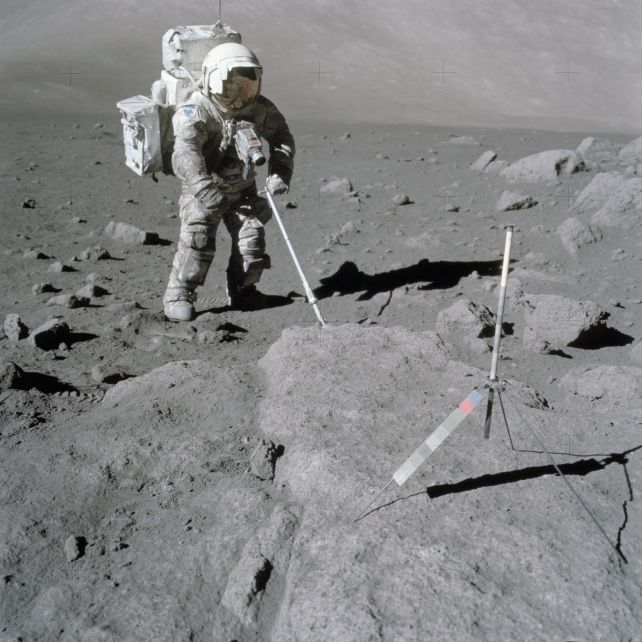A tiny sample of the Moon locked away for more than 50 years turns out to have been hiding an astronomical secret.
In specks of troilite dust collected by Apollo 17 in 1972, scientists have found material that may be as old – or even older – than the Moon itself, a 4.5-billion-year-old relic of the early Solar System.
"My first thought was, 'Holy shmolies, that can't be right,'" says planetary scientist James Dottin of Brown University in the US.
"So we went back to make sure we had done everything properly, and we had. These are just very surprising results."
Related: Curiosity Cracked Open a Rock on Mars And Discovered a Huge Surprise

During the 1960s and early 1970s, NASA's Apollo astronauts brought home to Earth a total of 382 kilograms (842 pounds) of lunar material for scientists to study in labs that had a full suite of equipment not available on the Moon.
However, these scientists knew that one day, more advanced technologies would vastly outperform their equipment, so they sealed up some of the rock samples to preserve them for that time.
It's one of these preserved samples that Dottin and his team studied, using mass spectrometry to determine the origin of sulfur in the sample.
Sulfur is an important element for understanding the geological history of an object. It can bond with metals such as iron, move between a planet's core, mantle, and atmosphere, and preserve the isotopic fingerprints of the environment where it formed.
Isotopes are versions of an element with different numbers of neutrons. Their ratios within a material differ depending on how that material was made – a chemical barcode of sorts, which scientists can use to trace a sample's origin, formation mechanism, and age.
The sample in Apollo 17 drive tube 73001/2 contained fragments of troilite, a compound of iron and sulfur most commonly found in space.
Dottin and his team wanted to study the isotope ratios of the sulfur in the troilite to learn more about the Moon's history, specifically targeting grains that looked like they were volcanic in origin.

Some parts of the sample had slightly elevated levels of sulfur-33, an isotope pattern consistent with volcanic degassing – and Dottin and team's expectations of lunar volcanic rock.
But then other parts of the sample showed the opposite: isotope ratios shockingly depleted in sulfur-33.
"Before this, it was thought that the lunar mantle had the same sulfur isotope composition as Earth," Dottin explains.
"That's what I expected to see when analyzing these samples, but instead we saw values that are very different from anything we find on Earth."
Related: It's Official: Scientists Confirmed What Is Inside Our Moon
Never before have scientists seen lunar samples with this isotope ratio, and there are limited ways it can form. This level of sulfur-33 depletion is indicative of an interaction between sulfur and ultraviolet light in a thin atmosphere, raising two intriguing possibilities – both of which suggest the troilite is ancient.
The first possibility is that the sulfur formed on the Moon itself, at a time when studies suggest a magma ocean covered the newborn Moon. As this ocean cooled and crystallized, sulfur-33 may have evaporated from the surface into the Moon's primordial atmosphere, leaving heavier isotopes behind.
The second option is even more intriguing. The leading theory for the formation of the Moon is that a newborn Earth was slammed into by a Mars-sized object named Theia in the pinball chaos of the early Solar System.
Some theories suggest the resulting debris remained in Earth orbit, coalescing into the Moon, while some of Theia disappeared into Earth's guts.
But some of Theia may also have remained with the Moon. And it's possible, the researchers say, that their bizarre lunar sulfur may have originated on Theia, too.
It's impossible to tell which scenario is more likely, but we can consider the implications anyway.
If the sulfur has been photochemically altered, that could be evidence of an ancient exchange of materials from the lunar surface to the mantle, Dottin says.
"On Earth, we have plate tectonics that does that, but the Moon doesn't," Dottin explains.
"So this idea of some kind of exchange mechanism on the early Moon is exciting."
The presence of the bizarre sulfur might also rule out the idea that the Moon coalesced from the dusty fallout of an Earth-Theia impact. If that happened, then sulfur would have been evenly distributed throughout the lunar mantle.

It's heady stuff – and it's just one sample that has been sitting locked away in a helium chamber since the 1970s.
No harm done, though. Resolving this mystery will probably require more extraterrestrial samples: from the Moon, from Mars, maybe even from asteroids. That's going to take time to collect.
Whatever its origin, these grains preserve the strangest, oldest sulfur signature ever found on the Moon, a breadcrumb trail leading us back to the very formation of the Solar System itself.
The research has been published in JGR Planets.

